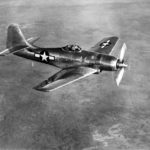XF8B-1
XF8B with drop tank 1946
XF8B
XF8B
Rear view
XF8B
XF8B
Six-blade contra-rotating propeller
XF8B
XF8B
The unpainted XF8B prototype BuNo 57984, 12 October 1944
Boeing XF8B-1 BuNo 57984 in flight
Boeing XF8B with contra rotating propellers
XF8B-1 BuNo 57984 on the ground
First XF8B-1 October 12, 1944
Boeing XF8B-1 BuNo 57984 in flight
XF8B (Model 400) was a single-engine aircraft developed by Boeing during World War II to provide the United States Navy a long-range shipboard multi-purpose aircraft. The XF8B-1 was the heaviest carrier based aircraft built up to to the end of WW2. It was powered by a 2,500 hp Pratt & Whitney four-row 28-cylinder engine. Boeing installed a six-blade contra-rotating propeller. It was able to carry up to a 2,900 kg bomb load, or two torpedoes, and was armed with 6 0.50-in machine guns or six 20-mm cannons. This machine undertook its maiden flight on 27 Novcmber 1944. But by the time the second and third prototypes joined the test program, the war was coming to an end, and no production orders were placed. The US Navy eventually accepted the first two prototypes in October 1946, and the last one in August 1947.
Bibliography:
- Phil H. Listemann: USN Aircraft 1922-1962: Type designation letters ‘F’ (Part Two)
- Kev Darling: American X & Y Planes: Volume I: Experimental Aircraft to 1945, Crowood Aviation Series, 2009
- Peter M. Bowers: Boeing Aircraft Since 1916, Putnam 1989
- Bert Kinzey, Rock Roszak: U. S. Navy and Marine Carrier-Based Aircraft of World War II















